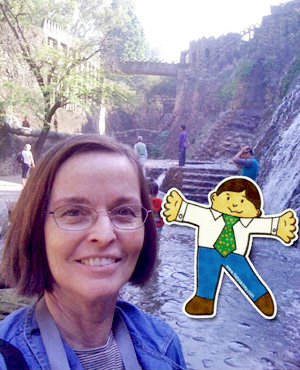Flat Stanley Goes Mobile: Fresh Start for Popular Global Ed Project
Introducing the new version of New Flat Stanley — a free phone app that lets you drop your custom-made flat person into a picture.
The Flat Stanley Project, one of the world's longest-running global education and literacy projects, has launched a new chapter. There's a brand-new website with increased interactivity and even a mobile app to track the globe-trotting adventures of Stanley Lambchop and his flat friends.

Perhaps best of all, the legal skirmishes that once threatened the wildly popular project have been amicably resolved. For project founder Dale Hubert, a recently retired Canadian teacher, "it's not so much a happy ending as a fresh start."
The Back Story
For anyone unfamiliar with the Flat Stanley Project, here's the abridged version. Flat Stanley is a children's book about a boy who gets squashed by a falling bulletin board only to discover that he's slim enough to travel in an envelope. Back in 1995, Hubert had his students make their own "flat people" out of paper and write about them. Then, they exchanged their journals and paper people with distant classrooms that Hubert had connected with online. When he launched the project, the Internet was in its infancy. Hubert had no idea the project would expand to engage students in more than 80 countries and turn Flat Stanley into a cultural icon, photographed with presidents and movie stars. Stanley has even accompanied astronauts into outer space.
When we last checked in with Hubert, however, there was trouble brewing in the Flatlands. The project was facing legal challenges from the estate of Jeff Brown, the late author of the original Flat Stanley book. Hubert had posted this message on the project home page: "Sadly, the Flat Stanley Project may be forced to end." When letters of support poured in from around the globe, the conflict quieted down to what Hubert calls "an uneasy truce."
A Team Comes Together
A couple years ago, Hubert was contacted by "some really smart guys" from Silicon Valley. They brought deep credentials in multimedia development along with access to capital. They enlisted Hubert as Chief Education Officer for a new venture called Flatter World and got busy building an iPhone app for Flat Stanley. Face-to-face meetings between the new team and the executor of Brown's estate led to a formal licensing deal. The executor is now on board as an adviser to the Flat Stanley Project, and Flatter World has exclusive mobile rights, Hubert says.
After nearly two decades of running the project as a one-man show, Hubert is still getting used to being part of a team that takes a businesslike approach. "It's a bit of a transition," he admits. But now he can focus on dreaming up new ideas for the classroom, knowing that his colleagues will attend to technical matters and new business development.
Blue Sky for Stanley
The refreshed Flat Stanley Project features a range of new features, with more in development.
The free iPhone app includes a slick camera tool that lets you drop your custom-made flat person into a picture. Then you can share photos online, email them to friends, or save them.
The new website offers increased interactivity. You can customize an avatar, choosing from a range of ready-made characters (including Stella, Stanley's female counterpart). You can customize their appearance with a click or design your own avatar from scratch. Mapping features allow you to follow individual "flat people" as they circle the globe electronically. You can "like" an avatar or post a comment.
The project has often been described as one of the earliest social networking sites. "Now it looks like a professionally designed, interactive site," Hubert says.
For teachers, a new feature called "find a host" makes it easy to set up classroom exchanges. Before photos are posted to the site, they are screened by the Flatter World team. "That reassures teachers that the content is appropriate," Hubert says. A variety of classroom resources are already available on the site, and Hubert is busy developing more. Eventually, he hopes to add a wiki to gather more ideas from educators.
Despite all the newfangled enhancements, the timeless power of the Flat Stanley Project comes from children sharing stories and making new friends. "It creates opportunities for kids to engage in authentic writing," Hubert says.
Over the years, he's seen projects engage students from kindergarten into their teens. Young children find it easier to write to a pen pal when they know they have a common friend in Flat Stanley. "It gives them a shared context to write about," he says. Teens who are sending Flat Stanleys to celebrities in hopes of getting a photo in return "are intrinsically motivated to produce their best writing. They know that somebody they admire is going to be reading it," he adds.
Now that he's retired, Hubert even has time to devote to his own writing. He recently completed his first children's book. Now he's working with an illustrator and dreaming up ideas for an accompanying social network. As he's learned from the Flat Stanley Project, there's always another chapter on the horizon.